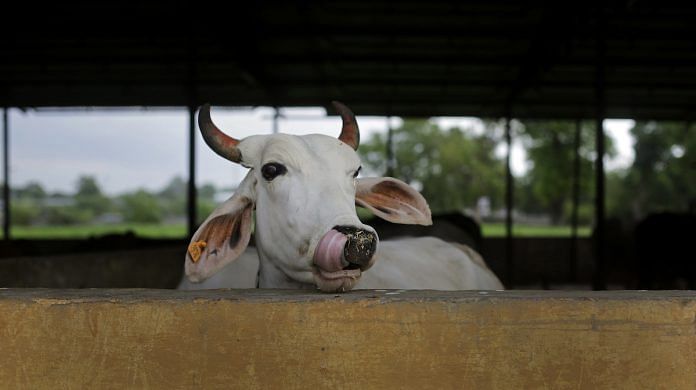New Delhi: The Narendra Modi government is planning a subsidy for dairy farmers that will help them procure special ‘sex-selection’ semen at a discount to ensure primarily-female progeny, ThePrint has learnt.
The government will subsidise each vial of the semen by Rs 200, bringing its cost down to Rs 400-500 from Rs 600-700, according to a source in the Union Department of Animal Husbandry and Dairying.
Around 2 lakh farmers are going to directly benefit from the subsidy, said the source.
The move, say industry experts, is expected to serve the twin purpose of boosting milk production and tackling the problem of stray cattle.
Most stray cattle is male because the advent of mechanisation in farming and ban on cow slaughter have made them redundant, often leading farmers to abandon them, leaving them to crowd streets and damage crops. Females, meanwhile, are precious property while they are at a nursing age.
This sex-selection semen — containing genes with the ‘X’ chromosome, as opposed to the ‘Y’ chromosome, which is present in males but not females — was imported until 2018, costing Rs 1,500/vial, but the Modi government has since opened several insemination centres to indigenously develop it.
The insemination centres were first set up in Uttarakhand and Maharashtra last year, as an experiment.
Amid an enthusiastic farmer response and increased milk production, according to the department source mentioned above, others were subsequently set up in Kerala, Himachal Pradesh, Karnataka, Madhya Pradesh, Punjab, Haryana, Gujarat, Telangana and Maharashtra.
“A lot of centres have opened up in the country since the BJP came to power,” Dr Chirantan Kadiyan of the Indian Veterinary Association, a government body, told ThePrint.
“Today, we are much ahead of other countries in artificial insemination of desi breeds. In some states, subsidy is being given on sperm. If the Centre also gives a subsidy, then farmers will benefit a lot,” he said.
The introduction of this process in India will help encourage the use of semen from indigenous breeds like Gir, Sahiwal, Kankrej etc alongside that of foreign breeds like Holstein-Friesian etc.
Dr Kadiyan said the government was also experimenting with in-vitro fertilisation of cattle with genital deformities.
There are around 30 crore cattle heads in India, according to a 2018 animal husbandry department report.
This includes about 8 crore that have no owners, according to this report, and are thus free to roam the streets and farms. Apart from the prospective damage they can cause, stray cattle is known to live in extreme deprivation and feed on garbage, which often includes plastic and other harmful material.
Also read: India’s dairy exports up 126% in FY19, courtesy a ‘boost’ from Modi govt scheme
The semen can last 10 years
Semen meant to produce a specific gender of cattle is derived through the sorted semen technique, which requires specimen to be preserved in liquid nitrogen at a temperature of minus 196 degrees Celsius. It can be stored thus for around 10 years.
An established practice in countries like the US and Japan, these injections ensure that 97 per cent of the offspring is female, said Dr Kadiyan.
The technique raises questions over whether the injection is yet another human attempt to play with nature, but Dr Kadiyan said the technique “will have no impact on nature”.
Adoption of this technique is expected to add around 3.75 crore milch animals to India’s livestock population.
“The production of milk is also expected to increase by 17.4 crore tonnes annually,” the animal husbandry department official said.
In 2016-17, India’s milk production was recorded at 16.5 crore tonnes, which increased to 17.6 crore tonnes in 2017-18, according to a June 2018 Lok Sabha reply by the then Minister of State for Agriculture Krishna Raj. She also said the projected milk production for 2021-22 is 25.4 crore tonnes.
According to information from the animal husbandry department, 30 per cent of indigenous female cattle in India are artificially inseminated. The government aims to raise the rate of artificial insemination to 80 per cent.
Also read: Forget synthetic meat, lab-grown dairy products are here




Is this technology available for buffaloes?
???????♂️?♂️?♂️?♂️?♂️ to our supreme leader
What will happen once these females stop producing milk?